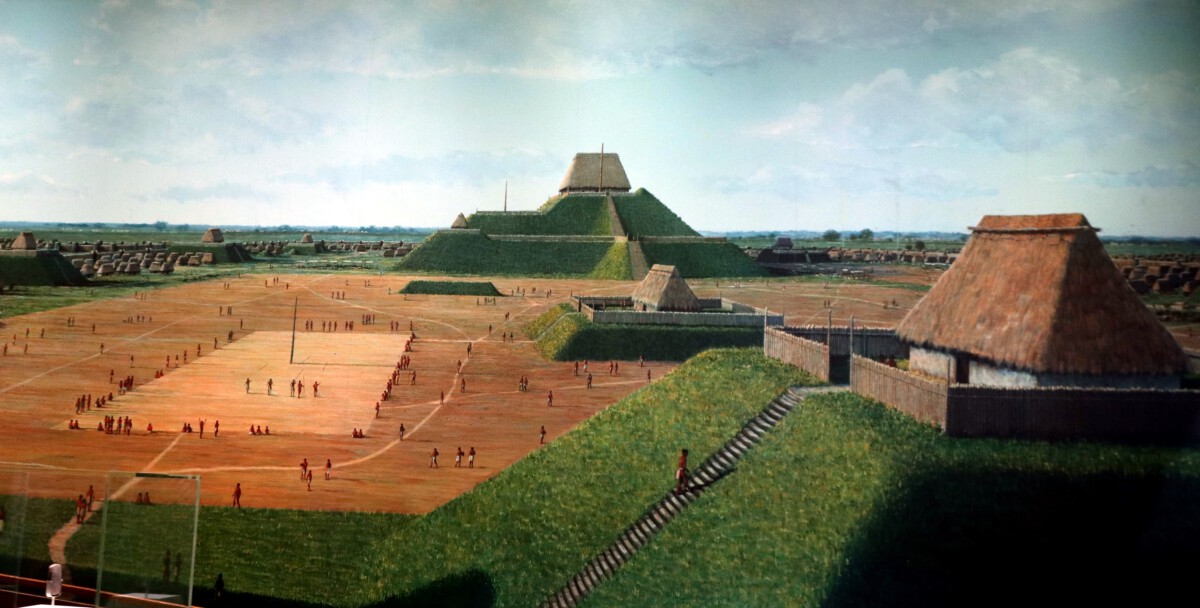Cahokia: The Ancient Wonder of Illinois

In the heart of modern-day Illinois lies the remnants of one of the most significant archaeological sites in North America. Cahokia, as it is known, was a sprawling prehistoric city that flourished long before European explorers set foot on the continent. This city, situated near present-day St. Louis, Missouri, was once the largest city north of Mexico, with a population that rivaled those of contemporary European cities. Unlike the bustling urban centers of today, Cahokia was constructed with earthworks and wooden structures, offering a unique glimpse into the ingenuity of its inhabitants.
The Mysterious Builders: The Mississippians

The architects behind Cahokia were part of the Mississippian culture, a civilization that thrived from approximately 800 AD to 1600 AD. These people were known for their advanced agricultural practices, intricate trade networks, and sophisticated political systems. They constructed large earthen mounds, which served as platforms for structures like temples and homes of the elite. Not much is known about the Mississippians’ written language or specific customs, adding an air of mystery to their impressive achievements. Their legacy, however, is etched in the landscape they transformed.
Monks Mound: The Heart of Cahokia

At the core of Cahokia stands Monks Mound, the largest earthen structure in North America. It rises about 100 feet high and covers 14 acres at its base. To put that into perspective, Monks Mound is larger at its base than the Great Pyramid of Giza. This monumental structure likely served as the political and religious center of Cahokia, housing the chief and serving as a platform for important ceremonies. The construction of such a massive mound required the movement of an estimated 22 million cubic feet of earth, a task that would have demanded a highly organized workforce.
Population and Urban Layout

At its peak, around 1050 AD to 1200 AD, Cahokia was home to somewhere between 10,000 and 20,000 people. This makes it comparable in size to many European cities of the same period. The city was meticulously planned, with a central plaza surrounded by mounds and residential areas. The layout suggests a society with distinct social hierarchies and specialized roles. The residents lived in wooden homes covered with thatch, and they relied heavily on agriculture, with corn being a staple crop.
The Decline of Cahokia

Despite its grandeur, Cahokia began to decline around 1300 AD. The reasons for this decline are still debated among historians and archaeologists. Some theories suggest environmental factors, such as overexploitation of resources or climate change, might have played a role. Others propose internal societal issues, like political strife or warfare. Whatever the reason, by the time European settlers arrived in the region, Cahokia was abandoned, leaving only the earthworks as silent witnesses to its past glory.
Discoveries and Excavations

The rediscovery of Cahokia in the 19th century sparked interest in North American archaeology. Since then, numerous excavations have uncovered artifacts like pottery, tools, and remains of wooden palisades. These discoveries have provided valuable insights into the daily lives and beliefs of the Mississippian people. The site was designated a UNESCO World Heritage Site in 1982, ensuring its preservation for future generations to study and admire.
The Cultural Significance of Cahokia

Cahokia’s cultural impact extends beyond its physical remnants. It represents a testament to the complexity and diversity of indigenous cultures in North America prior to European contact. The site challenges the misconception that advanced urban centers and intricate societies only existed in Europe and Asia. Cahokia’s existence serves as a reminder of the rich history that thrived on this continent long before it was called America.
The Role of Astronomy in Cahokia

Archaeologists have uncovered evidence suggesting that astronomy played a significant role in the lives of Cahokia’s inhabitants. The city features a woodhenge, a circle of wooden posts that likely served as a solar calendar. This structure indicates that the Mississippians had a keen understanding of celestial events, using them to mark seasons and plan agricultural activities. Such knowledge would have been vital for a society reliant on agriculture and ceremonial life.
Modern-Day Cahokia: A Site of Education and Reflection

Today, Cahokia Mounds State Historic Site offers a window into the past for visitors and scholars alike. With interpretive centers, guided tours, and educational programs, it provides an opportunity for people to connect with the rich legacy of the Mississippians. The site encourages reflection on the ingenuity and resilience of ancient cultures, highlighting the importance of preserving history for future generations.
Influence on Contemporary Native American Tribes

The legacy of Cahokia continues to resonate with contemporary Native American tribes. Many tribes today see Cahokia as a symbol of their ancestral heritage and a testament to the achievements of their forebears. The site fosters a sense of pride and identity, serving as a cultural touchstone that unites past and present. As such, Cahokia remains a vital part of America’s historical tapestry, a reminder of the diverse and vibrant cultures that have shaped the land.




